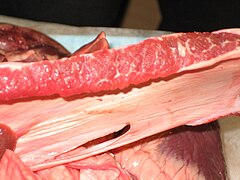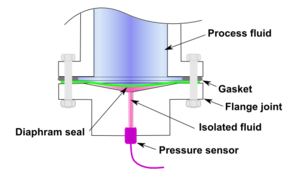diaphragm
Jump to navigation
Jump to search
English
[edit]Etymology
[edit]From Ancient Greek διάφραγμα (diáphragma, “partition”), from διά (diá, “across”) and φράγμα (phrágma, “barrier”), from the verb φράσσω (phrássō).
Pronunciation
[edit]- IPA(key): /ˈdaɪəˌfɹæm/
Audio (Southern England): (file)
Noun
[edit]diaphragm (plural diaphragms)
- (anatomy) In mammals, a sheet of muscle separating the thorax from the abdomen, contracted and relaxed in respiration to draw air into and expel air from the lungs; also called thoracic diaphragm.
- (anatomy) Any of various membranes or sheets of muscle or ligament which separate one cavity from another.
- A contraceptive device consisting of a flexible cup, used to cover the cervix during intercourse.
- (mechanics) A flexible membrane separating two chambers and fixed around its periphery that distends into one or other chamber as the difference in the pressure in the chambers varies.
- 1994 April 5, “Two Former Biosphere Workers Are Accused of Sabotaging Dome”, in The Associated Press[1]:
- There also were five broken panes of glass on the two huge, rubberlike diaphragms that equalize air pressure within the dome as the artificial atmosphere expands and contracts with temperature variations, he said.
- (acoustics) In a speaker, the thin, semi-rigid membrane which vibrates to produce sound.
- (optics, photography) A thin opaque structure with a central aperture, used to limit the passage of light into a camera or similar device.
- (chemistry) A permeable or semipermeable membrane.
- 1921, Wilder Dwight Bancroft, Applied Colloid Chemistry: General Theory[2], page 207:
- The mass of liquid transported through a porous diaphragm in a given time is directly proportional to the current.
- (construction) A floor slab, metal wall panel, roof panel or the like, having a sufficiently large in-plane shear stiffness and sufficient strength to transmit horizontal forces to resisting systems.
Derived terms
[edit]Translations
[edit]anatomy: sheet of muscle separating thorax from abdomen
|
anatomy: separating membrane or sheet of muscle
contraceptive device
|
mechanics: flexible membrane
|
acoustics: vibrating membrane in a speaker
|
optics: structure with a central aperture used to limit the passage of light
|
chemistry: permeable or semipermeable membrane
construction: stiff floor slab etc.
- The translations below need to be checked and inserted above into the appropriate translation tables. See instructions at Wiktionary:Entry layout § Translations.
Verb
[edit]diaphragm (third-person singular simple present diaphragms, present participle diaphragming, simple past and past participle diaphragmed)
- (optics, photography) To reduce lens aperture using an optical diaphragm.
- 1870, D. Appleton & Co., Appletons' Annual Cyclopædia and Register of Important Events of the Year 1869[3], page 43:
- He employs an equatorial with an object-glass having a focal length of five metres, and which was diaphragmed down to eight centimetres.
- To act as a diaphragm, for example by vibrating.
Translations
[edit]optics: to reduce lens aperture
|
Gallery
[edit]-
The thoracic diaphragm.
-
A mechanical diaphragm.
-
An acoustic diaphragm.
Categories:
- English terms derived from Ancient Greek
- English 3-syllable words
- English terms with IPA pronunciation
- English terms with audio pronunciation
- English lemmas
- English nouns
- English countable nouns
- en:Anatomy
- en:Mechanics
- English terms with quotations
- en:Acoustics
- en:Optics
- en:Photography
- en:Chemistry
- en:Construction
- English verbs
- en:Birth control
- en:Muscles



